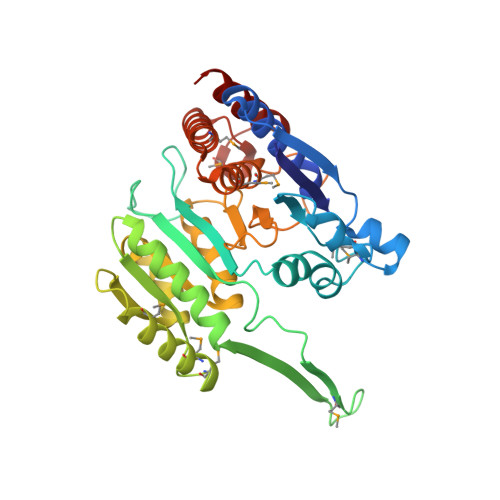Structural characterization of tartrate dehydrogenase: a versatile enzyme catalyzing multiple reactions.
Malik, R., Viola, R.E.(2010) Acta Crystallogr D Biol Crystallogr 66: 673-684
- PubMed: 20516620
- DOI: https://doi.org/10.1107/S0907444910008851
- Primary Citation of Related Structures:
3FLK - PubMed Abstract:
The first structure of an NAD-dependent tartrate dehydrogenase (TDH) has been solved to 2 A resolution by single anomalous diffraction (SAD) phasing as a complex with the intermediate analog oxalate, Mg(2+) and NADH. This TDH structure from Pseudomonas putida has a similar overall fold and domain organization to other structurally characterized members of the hydroxy-acid dehydrogenase family. However, there are considerable differences between TDH and these functionally related enzymes in the regions connecting the core secondary structure and in the relative positioning of important loops and helices. The active site in these complexes is highly ordered, allowing the identification of the substrate-binding and cofactor-binding groups and the ligands to the metal ions. Residues from the adjacent subunit are involved in both the substrate and divalent metal ion binding sites, establishing a dimer as the functional unit and providing structural support for an alternating-site reaction mechanism. The divalent metal ion plays a prominent role in substrate binding and orientation, together with several active-site arginines. Functional groups from both subunits form the cofactor-binding site and the ammonium ion aids in the orientation of the nicotinamide ring of the cofactor. A lysyl amino group (Lys192) is the base responsible for the water-mediated proton abstraction from the C2 hydroxyl group of the substrate that begins the catalytic reaction, followed by hydride transfer to NAD. A tyrosyl hydroxyl group (Tyr141) functions as a general acid to protonate the enolate intermediate. Each substrate undergoes the initial hydride transfer, but differences in substrate orientation are proposed to account for the different reactions catalyzed by TDH.
Organizational Affiliation:
Department of Chemistry, University of Toledo, Toledo, Ohio 43606, USA.





















